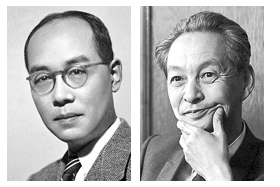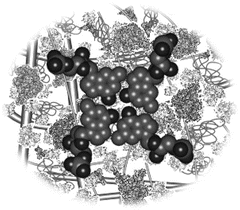The 7th interview of this series, as referred to us by Professor Itaru Hamachi (5th interview), is with Professor Naoki Sugimoto, director of the Frontier Institute for Biomolecular Engineering Research (FIBER) and professor at the Faculty of Frontiers of Innovative Research in Science and Technology (FIRST) at Konan University. Professor Sugimoto studies the physical chemistry of nucleic acids and related proteins, as well as the phenomenon of molecular crowding (or macromolecular crowding) in the life sciences. Please read on to find out more about him on a personal level!
[su_dropcap size=”2″]Q[/su_dropcap] What made you choose chemistry as a career?
[su_dropcap size=”2″]A[/su_dropcap]
My generation might be the last generation of scientists who looked up to Professors Hideki Yukawa (theoretical physicist and first Japanese Nobel Laureate) and Shinichiro Tomonaga (quantum physicist and Nobel Laureate) as role models. Most fortunately, I was blessed with the opportunity to directly learn from their wise words. I chose to devote myself to pure science because I aspired to learn the absolute truth behind the laws of nature rather than develop applications to a known field of study. At the time that I entered Kyoto University, the Faculty of Science was not divided up into many departments like it is today. There was no Department of Chemistry, or Physics, or Biology. In a very broad sense, I was drawn to physics the most. During my freshman/sophomore years, I attended lectures on statistical mechanics and thermodynamics by Professor Kazuo Yamazaki (a former student of the Nobel Laureate, Werner Heisenberg), which sparked my interest in unusual chemical phenomena at the molecular level (e.g., reactions that take place below the activation energy barrier via electron tunneling). From that point on, I decided to walk the path of a physical chemist in order to quantify chemical phenomena.
[su_dropcap size=”2″]Q[/su_dropcap]
If you were not a chemist, what would you like to be, and why?
[su_dropcap size=”2″]A[/su_dropcap]
If the question were “what did I want to be back then,” it would be a novelist. I like to imagine things and create new worlds. If I had any talent in literature, I would have certainly liked to become a novelist. If you asked me “what do I want to become today,” I guess it would still be a writer of some sort? Novels, of course, but also essays and reviews. I would like to spend my time writing about the world—literature, science, history, politics, religion, sports and music.
[su_dropcap size=”2″]Q[/su_dropcap]
Currently, what kind of research are you conducting? Moreover, how do you foresee its future development?
[su_dropcap size=”2″]A[/su_dropcap]
I study the physical chemistry of nucleic acids and related proteins. Francis Crick, who discovered the DNA double helix with James Watson, presented his hypothesis called “the central dogma of molecular biology” to describe theflow of genetic information from DNA à RNA à protein. From this hypothesis, the relationship between RNA sequences (codons) and amino acid sequences in a protein was found, resulting in a set of rules that translate genetic information to proteins, called the “genetic code.” This has been described in many textbooks and is appreciated by the general population as such. However, this “code” only describes the sequence of amino acids in a protein, and does not specify the structure of the resulting protein. What determines the higher-order structures of protein folding? Is there a possibility that the higher-order structures of RNA translate into the higher-order structures of a protein? Is a structure-determining unit, such as a protein-folding codon, hiding within the higher-order structures of RNA? I am invested in this new hypothesis and am currently studying the structural thermodynamics of nucleic acids and proteins.
My other aspect of research involves the concept of “Molecular Crowding” in life science. There is a big disconnect between what goes on in a solution within a test tube versus within a cell. The largest difference comes from the concentration of molecules. Within a test tube, the concentration of biomolecules (such as nucleic acids and proteins) is roughly 1 g/L, however, this number is on the order of several hundred grams per liter within a cell. This crowded environment—hence the concept of molecular crowding—should influence the structure, stability and function of biomolecules. I study such effects, and as a result, it is starting to be recognized that even the seemingly stable double helix of DNA can be destabilized under molecular crowding conditions. Therefore, I feel that DNA might be playing other important roles inside the cell/nucleus other than merely being the double helix that Watson and Crick described. I am discovering more and more biochemical phenomena at the molecular level that are quite distinct from textbook knowledge. In the future, my goal and aspiration is to predict and quantify biochemical phenomena within the cell.
[su_dropcap size=”2″]Q[/su_dropcap]
If you could have dinner with any famous person from the past, who would it be, and why?
[su_dropcap size=”2″]A[/su_dropcap]
Emperor Yang of Sui, Dōkyō, Nicolaus Copernicus, Nobunaga Oda, and René Descartes. These individuals may have been considered “evil” by some, but they all continuously challenged the norms of the era, exerting enormous influence on the people around them. If we are strictly limiting the choices to modern scientists, it would be Josiah Willard Gibbs, Friedrich Wilhelm Ostwald, Max Planck, Linus Pauling, and Francis Crick. These people have also challenged conventional logic and pioneered new scientific fields with groundbreaking hypotheses.
[su_dropcap size=”2″]Q[/su_dropcap]
When was the last time you performed an experiment in the laboratory, and what was it about?
[su_dropcap size=”2″]A[/su_dropcap]
This was not really my last experiment, but my most memorable experiment was performed when I was a postdoctoral research assistant at the University of Rochester in the United States. Maybe I was in my late 20s, maybe 30 years old. It was around the time when I slowly shifted from physical chemistry to the field of nucleic acid chemistry. It was around that same time that some RNA were found to have catalytic function, and were named “ribozymes.” The discoverer, Thomas Cech from University of Colorado—Boulder, had only begun to study the mechanism of ribozyme action at the time. I remember conducting biology experiments that I was not used to, but culturing E. coli and running gel electrophoresis were all new, enjoyable experiments for me. Maybe it was because there were not many scientists capable of quantitatively analyzing ribozymes at the time, but I was able to publish results faster than Cech’s group. That was in 1988—the following year, Cech received the Nobel Prize in Chemistry.
[su_dropcap size=”2″]Q[/su_dropcap]
If you were stranded on a desert island, which book or song/piece of music would you like to have with you? Please single out your favorite example.
[su_dropcap size=”2″]A[/su_dropcap]
For books, I would like to bring with me an entire collection of books that describe historical facts in detail. I would also like a very large collection that I cannot possibly read through. For music, I would like to have hits from the 60s and 70s. Group Sounds (a genre of Japanese rock), enka, and folk music—something that encompasses an entire era of music. On this deserted island’s sandy beach, I would like to listen to relaxing music and I would like to reflect on my past to re-discover myself for the future. This could be the zenith of my life, transcending the conundrum of life and death and the ultimate loneliness of being on a desert island.
[su_dropcap size=”2″]Q[/su_dropcap] Do you have any suggestions as to whom we should interview next?
[su_dropcap size=”2″]A[/su_dropcap]
I will introduce to you scientists who are unique, not necessarily in terms of personality, but in their thought processes. I think researchers who are younger than me would be good. Since Professor Itaru Hamachi (Kyoto University) already appeared on this interview series, how about Professors Yoshinobu Baba (Nagoya University), Hisakazu Mihara (Tokyo Institute of Technology),Mitsuhiko Shionoya (The University of Tokyo),Kouichi Fukase (Osaka University), Shiroh Futaki (Kyoto University) or Takehiko Wada (Tohoku University)? These unique individuals have come together to generate the Forum on Biomolecular Chemistry within the Chemical Society of Japan over 10 years ago, which was an epoch-making event.
[su_box title=”Biographical sketch of Naoki Sugimoto” style=”bubbles”]Naoki Sugimoto is currently the Director of the Frontier Institute for Biomolecular Engineering Research (FIBER) and professor at the Faculty of Frontiers of Innovative Research in Science and Technology (FIRST) at Konan University. He completed his Ph. D. in 1985 at the Graduate School of Science in Kyoto University. He then became a postdoctoral research associate at the University of Rochester (USA, 1985), after which he returned to Japan to begin his career as a Lecturer at the Faculty of Science and Engineering in Konan University (1988). He then rose through the rank of Assistant Professor (1991) to become a Professor in 1994, both in Konan University. He has received the Masao Horiba Award (inaugural award in 2004), International Copper Association (ICA) Distinguished Scientist Award(USA, 2005), the Hyogo Prefecture Science Award (2006), the 25th Chemical Society of Japan (CSJ) Award for Creative Work (2008), among others.[/su_box]
Japanese version written here on date (Nov 26, 2010); English translation written on May 5, 2014.
-
Related Books
[amazonjs asin=”0128000465″ locale=”US” title=”New Models of the Cell Nucleus: Crowding, Entropic Forces, Phase Separation, and Fractals, Volume 307 (International Review of Cell and Molecular Biology)”][amazonjs asin=”0123751381″ locale=”US” title=”Therapeutic Applications of Quadruplex Nucleic Acids”]
-
Related Links
-EPiC- NS group



